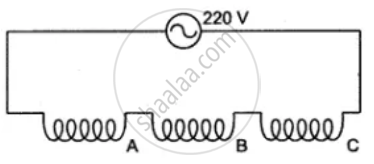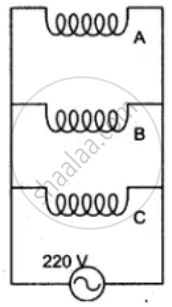Advertisements
Advertisements
प्रश्न
The diagram shows two ways of connecting three lamps P, Q and R to A.C. supply of 220 V.


उत्तर
The arrangement is shown in the figure (i) is a series arrangement. The arrangement in figure (ii) is the parallel arrangement.
We prefer a parallel arrangement. The reasons are:
(i) In series arrangement, if one of the bulbs is fused, the other bulbs also cease to glow. But in a parallel arrangement, if one bulb fuses, the other bulbs continue to glow.
(ii) In the series arrangement, while one bulb glows if the other bulb is switched on, the resistance of the circuit increases, and hence the bulbs glow less bright. But in a parallel arrangement, each bulb glows at the same voltage, therefore the glow of a bulb is unaffected if another bulb is switched on.
संबंधित प्रश्न
1 A = _________ mA
- 102
- 103
- 10-3
- 10-6
Which of the following units could be used to measure electric charge?
(a) ampere
(b) joule
(c) volt
(d) coulomb
Three 2 V cells are connected in series and used as a battery in a circuit.
How many joules of electrical energy does 1 C gain on passing through (i) one cell (ii) all three cells?
In a house there are 6 bulbs of 100 W each used for 4 hours a day, 4 bulbs of 60 W each used for 8 hours a day, an immersion heater of 2.5 kW used for 1 hour per day, and an electric iron of 800 W used for 2 hours per day. Calculate the cost of monthly electric bill for the month of April at the rate of 80 p per unit.
A bulb of 40 W is used for 12.5 h each day for 30 days. Calculate the electrical energy consumed.
An electrical gadget can give an electric shock to its user under certain circumstances. Mention any two of these circumstances.
Match the following:
| 1. | 1 mA | a. | series |
| 2. | 1 pA | b. | ohmmeter |
| 3. | Ammeter | c. | 10-6 ampere |
| 4. | Electrical resistivity | d. | 10-3 ampere |
